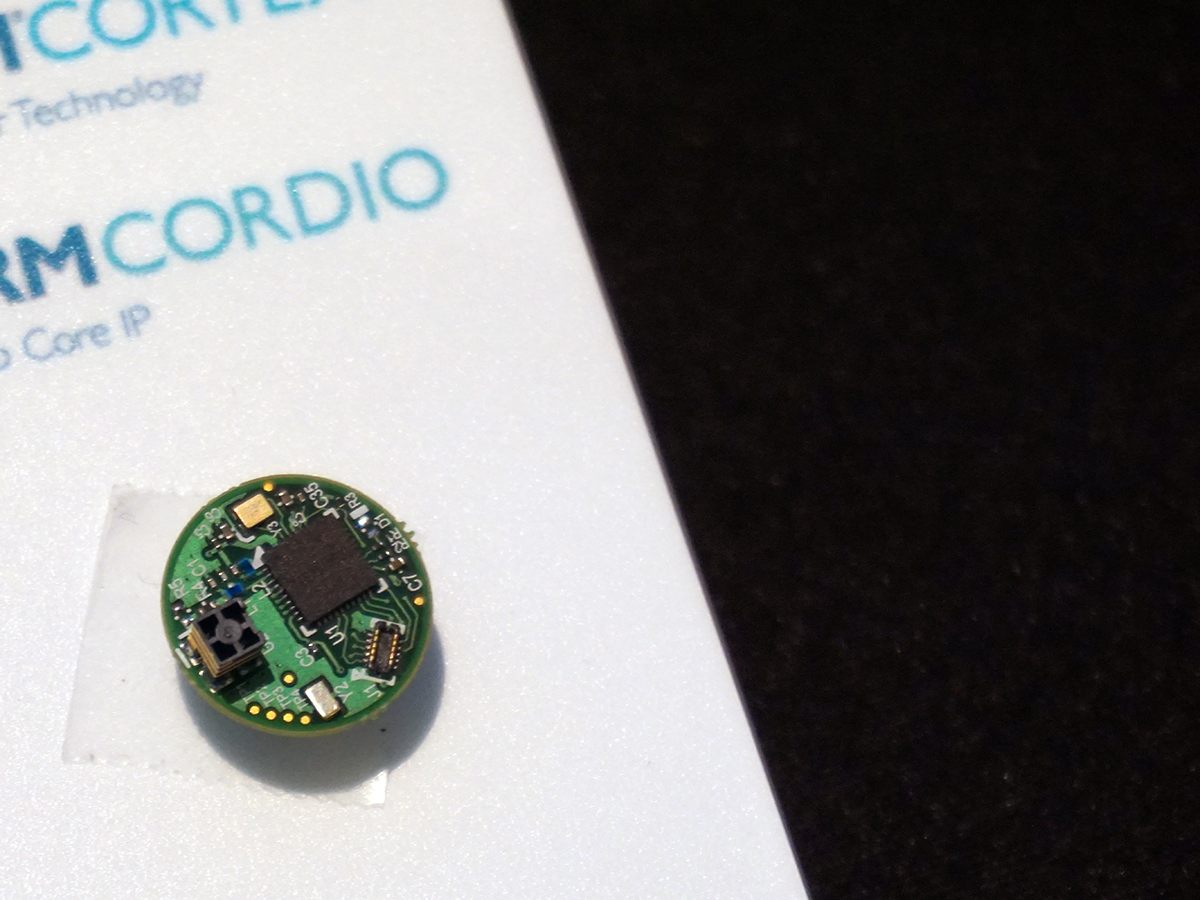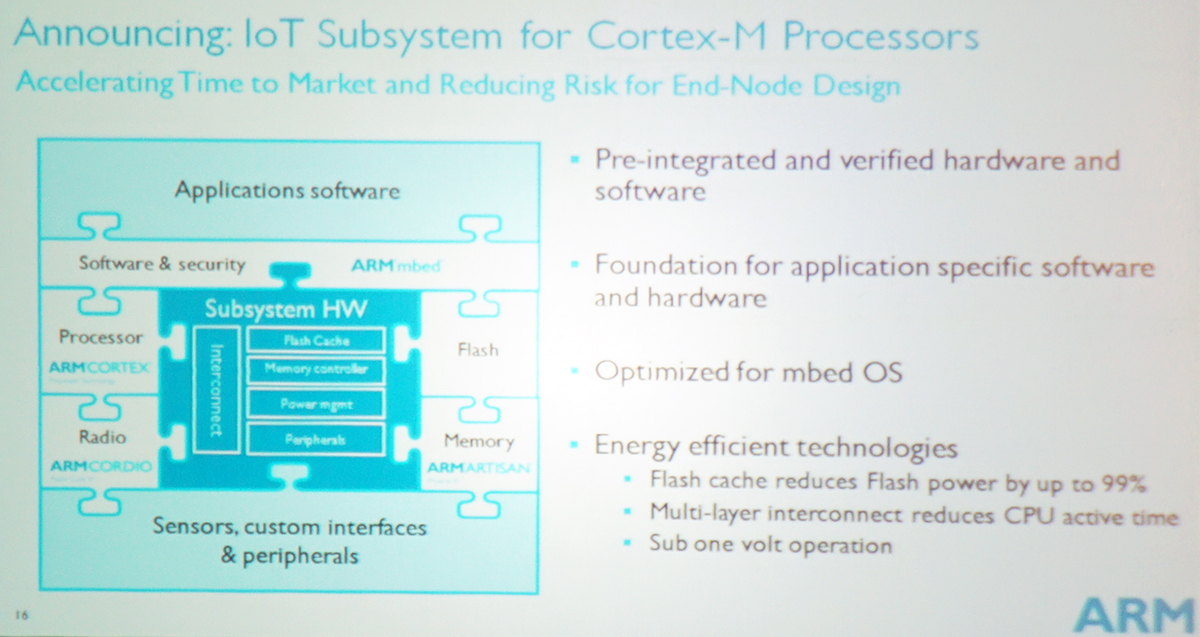ARM's 'Little Data,' Low-Power Cordio Radio IP, And IoT Subsystem
At ARM's Computex 2015 press conference, the company touted its latest efforts in IoT, a three-pronged approach that includes a new sub-1 volt Radio IP design, an IoT subsystem for Cortex-M processors, and upcoming software updates to the mbed OS platform.
No one can ignore the fact that computing has evolved dramatically over the past decade, bringing new and different devices and experiences, as well as an unprecedented push to connectivity. With IoT, ARM is looking past the billions of computing devices across the world to the trillions of sensors that bring intelligence to all manner of devices – mobile phones and computers, sure, but also homes, cities, cars, wearables, HMDs and more.
Dipesh Patel, ARM's Executive Vice President of Technical Operations, said from the stage that you must take sensors into account when talking about connected devices – even sensors in your mobile phone that exist and function independently from the phone itself. It's the "little things," Peyal said, that ARM wanted to talk about today.
Those little things, though, present a number of obstacles. There are several issues that ARM has identified and is attempting to solve. These trillions of sensors require some sort of connectivity, and their power requirements have to be so minimal as to last years, not hours or days. Further, the wide community of developers need to be able to design and deploy their devices easily – and securely.
Cordio Radio IP
The new design that ARM is touting is the Cordio Radio IP. The result of ARM's recent acquisition of Sunrise Micro Devices, the Cordio Radio was designed from the ground up for low power. Indeed, it runs on less than one volt. Despite its incredibly small power demands, it's fully certified for Bluetooth 4.2, and ARM billed it as a "full radio solution, from RF to application."
At less than a volt, ARM claimed that the Cordio Radio will offer 60 percent more battery life than 1.2 V devices on alkaline batteries and can double the battery life on those devices on lithium batteries.
ARM showed the IP manifested in a tiny microbeacon, which you can see above.
Get Tom's Hardware's best news and in-depth reviews, straight to your inbox.
IoT Subsystem For Cortex-M Processors
To enable easy integration for developers and designers, ARM announced a new IoT subsystem for Cortex-M processors. This subsystem contains flash cache, a memory controller, power management and peripherals. ARM said that it worked closely with TSMC on the flash component, building a controller on the 55nm ultra low power platform (55ULP) that minimizes the amount of power consumption at the system level.
ARM claimed that it requires less than a volt of juice and that, thanks to the TSMC 55ULP, it reduces power leakage by 25 percent, and dynamic power by 44 percent, compared to a 1.2 V solution. It's also optimized for mbed OS.
Software And "Little Data"
ARM's Krisztian Flautner, General Manager of Internet of Things Business, touted the importance of software to complete the IoT picture. ARM has pursued creating software that makes it easier for developers to build and connect devices to the Internet with mbed OS for IoT. It sounds like a tall task, and of course it is, but Flautner noted that the type of software needed to run different IoT applications, such as smart homes, smart cities and wearables, is all actually quite similar.
To augment the usefulness of mbed OS, ARM developed the mbed Device Server as a means to better connect IoT devices to their host services or apps. The company compared it to a web server; just as a web server "accepts connections from mobile phones or web browsers, a Device Server handles the connections from Internet of Things (IoT) devices," or so says ARM's mbed Device Server site.
Within this somewhat familiar structure of servers, OSes, and devices is a bit of different thinking about the volume of data involved in IoT. The data flowing from IoT devices is diverse and voluminous, yes, but it's also comprised of very small bits. Remember, much of this data is simple communications from a simple sensor.
Flautner called this "little data," because the emphasis is on the sensors sending data to the cloud, not on the data analytics (e.g., big data).
To pull off its big IoT dreams, and even though it's designing so many components, ARM still needs an ecosystem of partners. Flautner noted that ARM's partners fill in its gaps in areas such as actual sensors, gateways and more.
To give those partners something to buy into, ARM announced its mbed Enabled program, which is designed to make it easier for devs to get the software they need to develop their devices and applications.
"ARM mbed Enabled accreditation program is designed for mbed developers and partners who want to clearly identify their product(s) as interoperable mbed Enabled technologies," reads the mbed Enabled site. "The program is available for any development board, component, chipset, project, product, service etc. that is developed with mbed technology and meets the specified criteria."
Interested parties can explore the mbed Enabled program here.
(Note: ARM did not provide press with slides of the presentation, and thus we resorted to using the hastily-snapped photo you see above.)
Seth Colaner is the News Director at Tom's Hardware. Follow him on Twitter @SethColaner. Follow us @tomshardware, on Facebook and on Google+.
Seth Colaner previously served as News Director at Tom's Hardware. He covered technology news, focusing on keyboards, virtual reality, and wearables.


